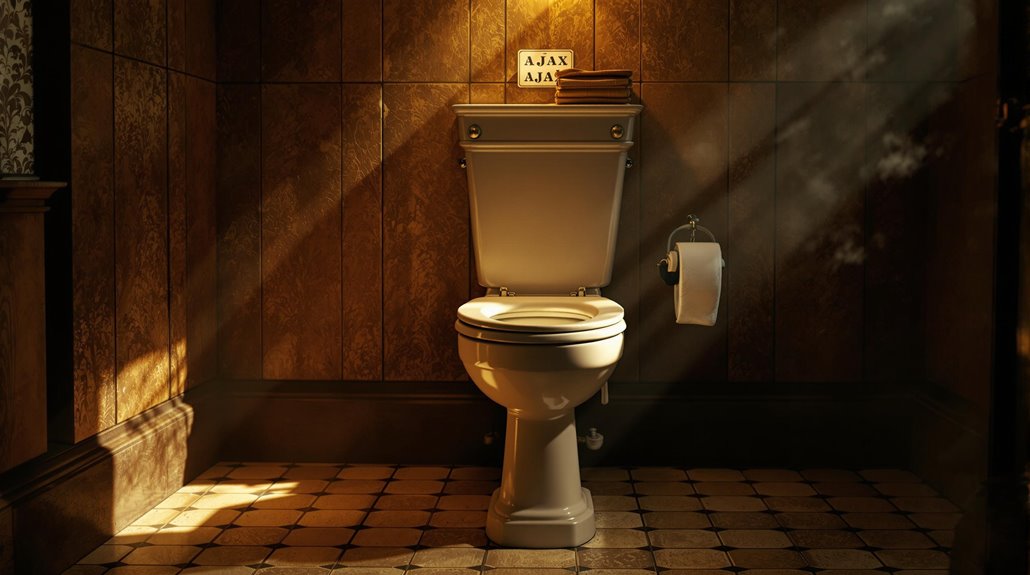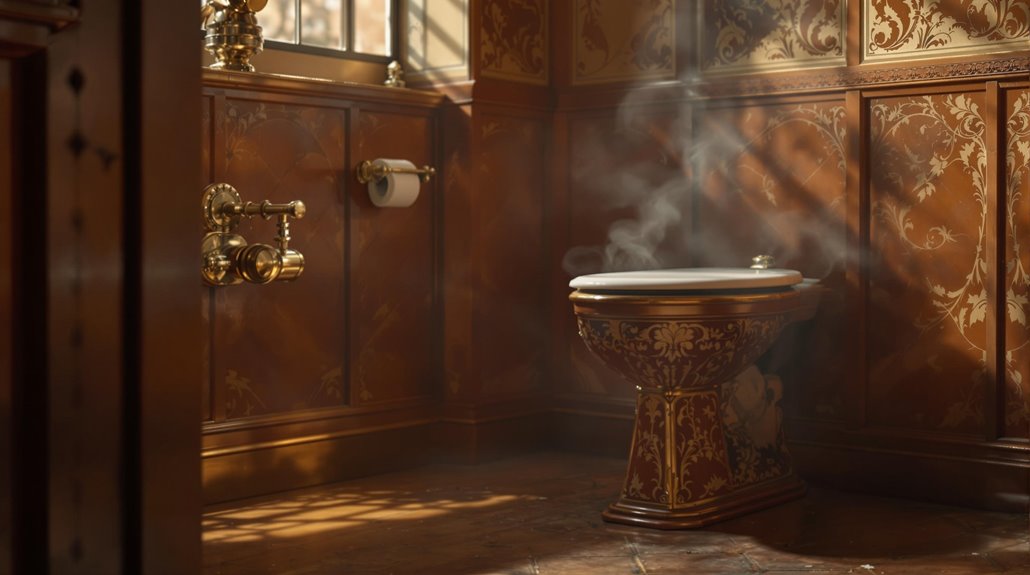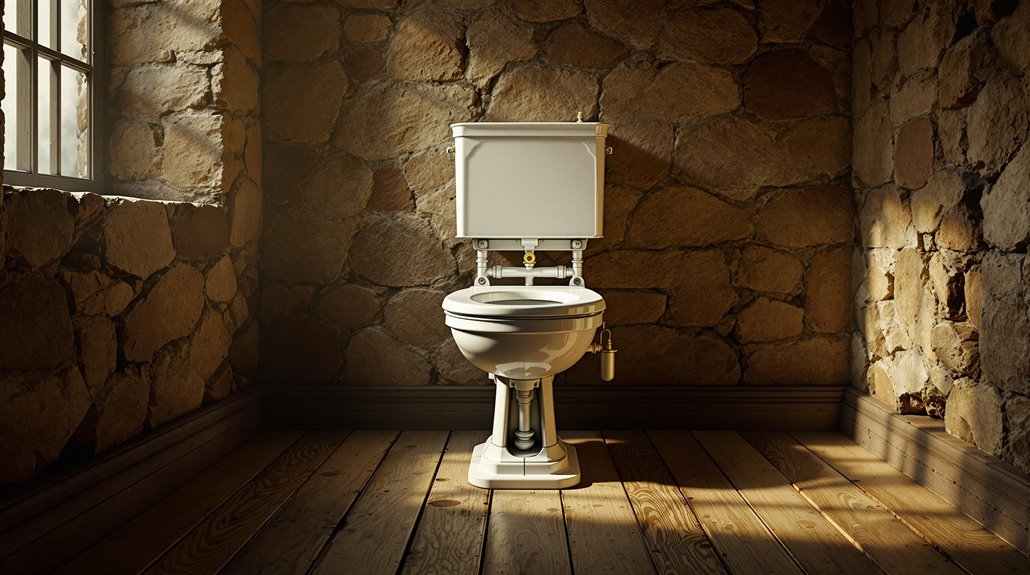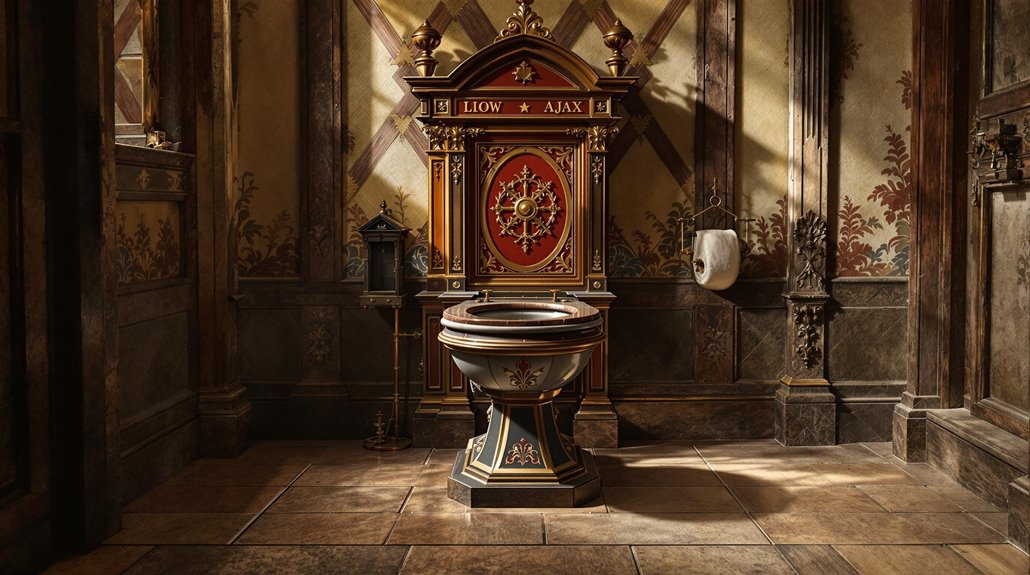John Harrington’s “Ajax”: The Flush Toilet That Shocked Elizabethan Nobles
You've likely never considered how a toilet could scandalize an entire royal court, but that's exactly what happened in 1584 when Sir John Harrington revealed his "Ajax." While modern bathrooms wouldn't raise an eyebrow today, this revolutionary device sent shockwaves through Elizabethan society. From Queen Elizabeth's personal approval to horrified nobles clutching their pearls, the story behind this first flush toilet discloses as much about Tudor sensibilities as it does about sanitation innovation.
The Making of a Royal Innovation

Though now a common fixture in modern homes, the flush toilet began as a royal innovation in Elizabethan England. You might be surprised to learn that royal inspiration struck Sir John Harrington, Queen Elizabeth I's godson, during his exile from court in 1584.
After being banished for writing provocative poetry, he retreated to his Kelston estate where innovative necessity sparked his creation. The invention was a vast improvement over the standard chamber pots and cesspits that plagued medieval cities.
During his seven-year exile, Harrington developed the "Ajax," a clever pun on "a jakes" (a common toilet term). His invention featured a sophisticated system of handles, levers, and weights, complete with a water cistern that delivered two gallons per flush.
When Queen Elizabeth I visited Kelston in 1592, she was so impressed by the Ajax that she ordered one for herself, marking a royal seal of approval for this groundbreaking invention. The innovative design included a leather-faced valve that sealed the bottom opening of the pan.
Breaking Down the Ajax Design
Three key components formed the revolutionary design of Harrington's Ajax: a bowl with a bottom valve, a water cistern mounted above, and an intricate system of levers and weights.
The design specifications included a leather-faced valve that sealed the bowl's opening, while the cistern stored 7.5 gallons of water, enough for 20 uses before requiring a manual refill.
When you'd turn the handle on the seat, the flushing efficiency came from a simple yet effective mechanism. The lever system would lift the valve, releasing water from the cistern to sweep waste into a cesspool below. Despite its ingenuity, the Ajax faced initial societal resistance due to cultural taboos. His invention would later save countless lives through improved sanitation and disease prevention.
This gravity-fed operation made the Ajax remarkably effective at separating waste from living areas and reducing odors. You'd find this groundbreaking system installed in Richmond Palace by 1598, marking a significant advancement in sanitation technology.
A Courtier's Quest for Better Sanitation
While most Tudor aristocrats ignored the squalid state of English sanitation, Sir John Harrington took action during his exile from Queen Elizabeth's court in 1584.
You'd think a man banished for writing risqué stories would've wallowed in self-pity, but Elizabeth's "saucy Godson" used his time at Kelston to revolutionize courtly hygiene.
Harrington's motivation stemmed from witnessing the devastating effects of poor sanitation in England's cities.
Drawing inspiration from Roman and monastic systems, he sought to create a solution that would transform noble etiquette around waste disposal. His invention included a revolutionary cistern and pipe system that would effectively remove waste from noble households.
His invention, cleverly named "Ajax" as a pun on "a jakes," wasn't just about improving sanitation – it was his ticket back into the Queen's good graces, which he achieved when presenting his design in 1592.
Reactions From the Tudor Elite
Despite its innovative design, Harington's Ajax flush toilet sparked divided reactions among Tudor nobility when it debuted in 1592. You'd find some courtiers praising its novelty and potential to improve Tudor hygiene, while others dismissed it as vulgar and beneath their station.
Queen Elizabeth I's response proved particularly fascinating. Though she'd initially banished Harington for his lewd translations, she visited his home to inspect the Ajax herself. Impressed by the invention, she even tested it and ordered one for Richmond Palace. His reputation as a fine poet helped soften the reception of his controversial invention.
The device's impact extended beyond its practical function, becoming a vehicle for court satire. Harington's accompanying book cleverly disguised political criticism, particularly of the Earl of Leicester, leading to controversy and temporary banishment. His 1596 publication "A New Discourse" detailed the invention's specifications while mixing humor with social commentary.
While the Ajax represented a significant advancement over chamber pots, most nobles viewed it as an amusing curiosity rather than a necessity.
Beyond the Palace Walls: Early Adoption Challenges

Although Harington's Ajax found favor within palace walls, its adoption beyond the royal court faced substantial obstacles in 16th century England. The steep installation costs and lack of widespread plumbing infrastructure created significant economic obstacles, limiting the technology to wealthy nobles.
Cultural resistance proved equally challenging, as you'd find most people clinging to traditional chamber pots and outdoor privies. The Tudor public's conservative attitudes, combined with societal taboos about discussing bodily functions, made them skeptical of this innovative sanitation solution. Only wealthy private homes featured these indoor facilities.
Technical limitations further complicated matters. Early plumbing systems struggled with unreliable water pressure, while primitive sewage systems couldn't handle increased water flow.
The absence of skilled craftsmen and standardized parts meant that maintaining these revolutionary devices remained problematic for those few who could afford them.
The Birth of Modern Plumbing Standards
Once primitive and unregulated, plumbing systems underwent a revolutionary transformation in the early 20th century with the publication of the landmark "Hoover Code" in 1928.
This groundbreaking document marked the beginning of modern sanitary engineering, establishing essential safety standards that you'll still find in today's plumbing systems. The surge in urban development during this period led to the creation of formal plumbing codes to address growing health concerns. Prior methods involving chamber pots and window disposal had contributed to widespread disease outbreaks in cities.
The plumbing evolution gained momentum through the work of Dr. Roy B. Hunter at the National Bureau of Standards. His research revolutionized how we approach plumbing design and safety.
Key developments in modern plumbing standards include:
- Formation of the A40 committee to create detailed plumbing standards
- Publication of the first National Plumbing Code in 1955
- Implementation of water conservation requirements starting in 1978
Today's codes continue to evolve, incorporating sustainable practices and new technologies while building upon these foundational principles.










